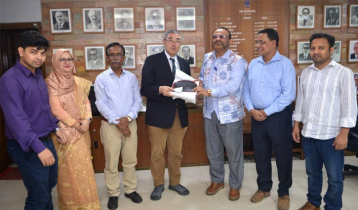Another nearby planet found that may be just right for life
3 || risingbd.com

Photo taken from internet
Risingbd Desk: Astronomers have found yet another planet that seems to have just the right Goldilocks combination for life: Not so hot and not so cold. It’s not so far away, either.
This new, big, dense planet is rocky, like Earth, and has the right temperatures for water, putting it in the habitable zone for life, according to a study published Wednesday in the journal Nature.
It’s the fifth such life-possible planet outside our solar system revealed in less than a year, but still relatively nearby Earth. Rocky planets within that habitable zone of a star are considered the best place to find evidence of some form of life.
“It is astonishing to live in a time when discovery of potentially habitable worlds is not only commonplace but proliferating,” said MIT astronomer Sara Seager, who wasn’t part of the study.
The first planet outside our solar system was discovered in 1995, but thanks to new techniques and especially NASA’s planet-hunting Kepler telescope, the number of them has exploded in recent years. Astronomers have now identified 52 potentially habitable planets and more than 3,600 planets outside our solar system.
The latest discovery, called LHS 1140b, regularly passes in front of its star, allowing astronomers to measure its size and mass. That makes astronomers more confident that this one is rocky, compared to other recent discoveries.
In the next several years, new telescopes should be able to use the planet’s path to spy its atmosphere in what could be the best-aimed search for signs of life, said Harvard astronomer David Charbonneau, a co-author of the study. If scientists see both oxygen and some carbon in an atmosphere, that’s a promising sign that something could be living.
Outside astronomers have already put this new planet near the top of their must-see lists for new ground and space-based telescopes.
“This is the first one where we actually know it’s rocky,” Charbonneau said. “We found a planet that we can actually study that might be actually Earth-like.”
Make that super-sized, because it belongs to a class of planets called super-Earths that are more massive than Earth but not quite the size of giants Neptune or Jupiter.
Compared to Earth, the new planet is big, pushing near the size limit for rocky planets. It’s 40 percent wider than Earth but it has 6.6 times Earth’s mass, giving it a gravitational pull three times stronger, Charbonneau said. A person weighing 167 pounds would feel like 500 pounds on this planet.
While many super-Earths are too big to have the right environment for life, 1140b is just small enough to make it a good candidate. Thirty-two of the potentially habitable planets found so far are considered super-Earth sized.
The new planet was found using eight small telescopes in Chile and help from an amateur planet-hunter, Charbonneau said.
In the constellation Cetus, it is 39 light years or 230 trillion miles away. So are a group of seven mostly Earth-sized planets in or near the habitable zone found circling a star called Trappist-1 earlier this year, but it in a different direction. And in August, astronomers found that the nearest planet to Earth outside our solar system, only 25 trillion miles away, also could have the right temperature for life, but astronomers can’t get a peek at its atmosphere.
“If you picture the Milky Way as the size of the United States, then these systems are all within the size of Central Park,” Charbonneau said. “These are your neighbors.”
The latest discoveries have their founders at odds over which of the planets are the most promising. Charbonneau said recent studies show that the Trappist planets may not be rocky like Earth, while Trappist discoverer Michael Gillon said the newest planet has such intense gravity that its atmosphere may be smooshed down so telescopes can’t get a good look at it.
Seven outside astronomers said the Milky Way is big enough for all the discoveries to be exciting, requiring more exploring.
Yale astronomer Greg Laughlin, who wasn’t part of any of the teams, praised all the new findings but said the Trappist planets seem too light and the new one too dense for his taste: “I wouldn’t book a trip to any of these planets.”
Agencies
risingbd/Dhaka/Apr 20, 2017/Nasim
risingbd.com























